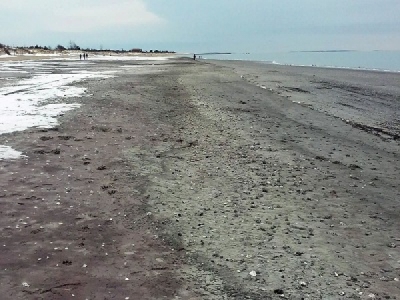
Posted on February 8, 2018
By Sarah Page Kyrcz, ShoreLine Times
Hammonasset State Beach will be safe to enjoy when the warmer weather returns, contrary to citizens’ concerns that the new sand from a recent dredging project is not safe, according to state officials.
Visitors to Hammonasset aired their concerns on social media about the look of the project and quality of the new sand.
But, Brian Thompson, director of land and water resources division at the state Department of Energy and Environmental Protection Thompson said testing was done prior to the dredging project and it is free of contaminates and safe for beach use.
The project, to relocate about 250,000 yards of sand from the mouth of the Housatonic River onto the western end of Hammonasset Beach State Park to supplement and “nourish” the beach, was completed in December.
“There was a lot of interest from the town of Stratford, primarily, and also the town of Milford, to have the mouth of the Housatonic River dredged to improve its accessibility, largely for recreation boating purposes,” Thompson told the ShoreLine Times in November.
“That is now happening and because it was good sand we wanted to use it beneficially by placing it on the beach,” he added. “That western end of Hammonasset was getting narrow and it does erode over time…so that was a good use of the sand.”
As far as the concerns that the Housatonic River has a history of contamination, Thompson stressed that the sand was taken from “the very lower end, near the mouth of river. The PCB contamination happened well up river, Massachusetts was the original source of the PCB contamination,” he said in an interview last week.
He added, however, “certainly sediment moves downstream…there wasn’t a significant concern that PCBs would be in that lower part of the river from that far upstream source and sampling confirms there were not.”
The report for the project, “Soil Analytical Data Housatonic River Sediment Sampling March 2007,” shows there are no PCBs in the sand that was in that section of the Housatonic River.
As for the date of the study, Thompson said that in 1999 and in 2007 sampling was done with very similar results.
“There was no reason to believe there was any additional contamination that would have occurred between 2007 and 2015, when this (the dredging project) was starting to be reviewed,” he added.
“They don’t show much and it’s sandy material, and contaminates don’t tend to attach to sand,” he added.
Branford resident Martin Adamo, who often walks at Hammonasset, was very concerned about the situation and contacted state officials. In addition, he posted his concerns and photos on Simply Guilford, CT Facebook in mid-December, resulting in 38 comments from the public.
Since that time, he has revisited the site and found it has begun to look a bit better.
“It certainly looks a lot better than it did when I took the pictures and was seeing the results of a lot of different things going on,” said Adamo.
“You have to remember if you’re walking somewhere, it looks beautiful every day and you get there and there’s piles of mud, big brown bubbles and birds looking funny and engorged and everything that I saw, it was kind of a shock to me.
“I definitely feel better that A. they got back to me and B. there was some kind of an explanation,” he added.
Asked whether any of the dredged material could make animals sick, Thompson surmised that the animals would have found an abundance of food source from the material taken from the bottom of the river and they may have been “just suffering the effects of overeating.
“I don’t think there was any concern that there was contamination or exposure to something,” he added.
There were also videos on Simply Guilford, CT of foam washing up in the waves, leaving bubbles on the beach. Thompson explained, “You see that a lot, actually, in streams, too, when they get really turbulent and where there’s a lot of organic matter from leaves and other organic debris.
There’s a lot of turbulence, in this case it’s wave action and again, I think that woody debris and organic matter that’s in the sediment creates that foaming condition,” he added.
The grayish color of the new sand is markedly different than the sand that has been at Hammonasset for years, which Thompson said was normal since it came from a river bottom
“Some portion of that is organic material and it will wash out or bleach out over time,” he added.
Yet, while he admitted that the difference between the old sand and the new sand will probably be noticeable, he stressed that does not mean that it is something that the public should worry about.
“There will be certainly areas that are a high percentage of the sand that came out of the river,” he said. “But just because it came from a river, again, doesn’t mean it’s bad sand. It’s actually fine and very soft, so it should actually should be good for beach use.”
Source: ShoreLine Times





